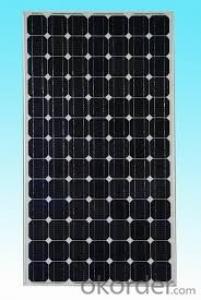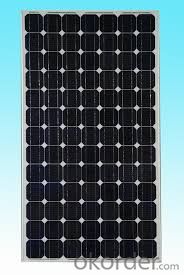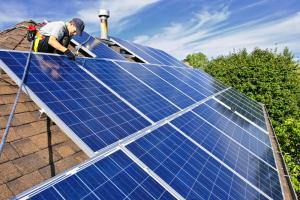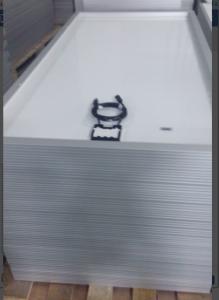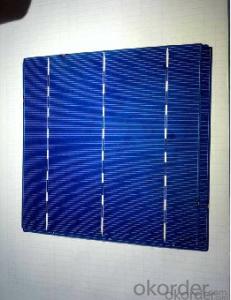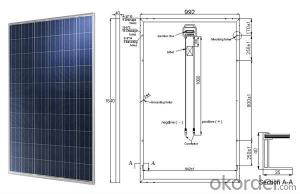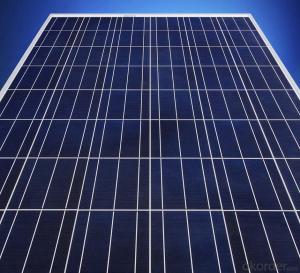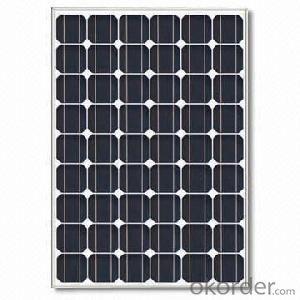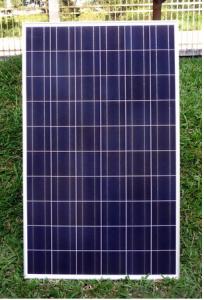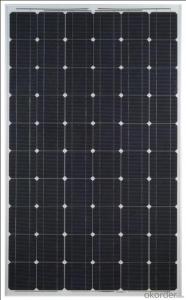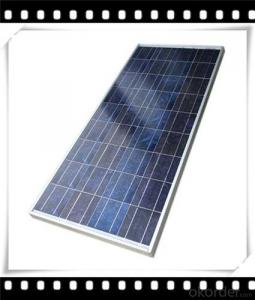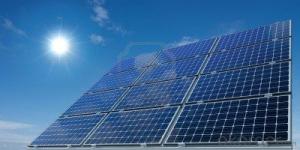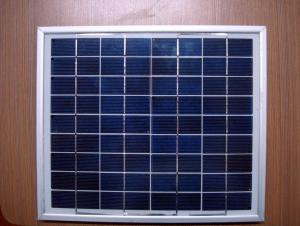30w Small Monocrystalline Solar Panel with Good Quality CNBM - Solar Panels Bakersfield CA
- Loading Port:
- Qingdao
- Payment Terms:
- TT OR LC
- Min Order Qty:
- 10 set
- Supply Capability:
- 300000 set/month
OKorder Service Pledge
OKorder Financial Service
You Might Also Like
Mini Monocrystalline Solar Panel with 30W
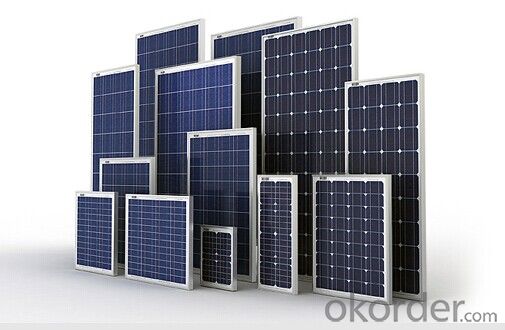
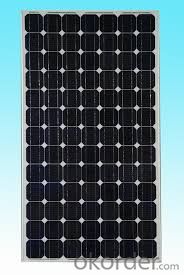
Monocrystalline Solar Modules
We offers a range of small, medium and large monocrystalline solar modules, designed for a range of requirements.
Specifications:
Tolerance | +/- 3% |
Cell | Monocrystalline silicon solar cells |
N0. of Cells | 72 (12 x 6) |
Dimension of Modules (mm) | 1581 x 809 x 40 |
Weight (kg) | 15.5 |
Limits:
Operating Temperature | -40~+85? |
Storage Temperature | -40~+85? |
Maximum System Voltage | 1000 VDC max. |
Hail Impact | Diameter of 28mm with impact speed of 86km/h |
Temperature and Coefficients:
NOCT | 48C+/-2? |
Voltage temperature coefficient (%/K) | -0.34 |
Current temperature coefficient (%/K) | 0.09 |
Power temperature coefficient (%/K) | -0.37 |
Characteristics:
Model: | SGM-160D | SGM-165D | SGM-170D |
Max-power voltage Vmp (V) | 34.5 | 35.4 | 35.8 |
Max-power current Imp (A) | 4.64 | 4.66 | 4.75 |
Open-circuit voltage Voc (V) | 41.75 | 43.6 | 43.32 |
Short-Circuit Current Isc (A) | 5.32 | 5.08 | 5.38 |
Max-power Pm(W) | 160 | 165 | 170 |
Model: | SGM-175D | SGM-180D | SGM-185D |
Max-power voltage Vmp (V) | 36.1 | 36.2 | 36.2 |
Max-power current Imp (A) | 4.85 | 4.97 | 5.11 |
Open-circuit voltage Voc (V) | 43.68 | 43.8 | 44.8 |
Short-Circuit Current Isc (A) | 5.49 | 5.48 | 5.51 |
Max-power Pm(W) | 175 | 180 | 185 |
STC: Irradiance 1000W/m2, Module temperature 25?, AM=1.5
Monocrystalline Solar Panels Specifications Range
Maximum Power (Pm) | Dimension | Weight | Operating Voltage (Vmp) | Operating Current (Imp) | Open Circuit Voltage (Voc) | Short Circuit Current (Isc) |
3W | 158x241x25mm | 0.5kg | 8.5V | 0.36A | 10.5V | 0.4A |
4W | 308x166x25mm | 0.77kg | 8.5V | 0.47A | 10.5V | 0.54A |
4W | 308.x166x25mm | 0.77kg | 16.8V | 0.24A | 21V | 0.27A |
5W | 296x215x25mm | 0.3kg | 16.8V | 0.48a | 21V | 0.54A |
10W | 286x406x25mm | 1.5kg | 16.8V | 0.59A | 21V | 0.66A |
12W | 286x406x25mm | 1.5kg | 16.8V | 0.71A | 21V | 0.8A |
14W | 286x541x25mm | 2kg | 16.8V | 0.83A | 21V | 0.96A |
16W | 286x541x25mm | 2kg | 17.2V | 0.93A | 21.5V | 0.99A |
18W | 296x541x25mm | 2.4kg | 18.8V | 1.07A | 21V | 1.2A |
20W | 296x641x25mm | 2.4kg | 17.2V | 1.15A | 21.5V | 1.24A |
24W | 541x451x25mm | 3.15kg | 16.8V | 1.14A | 21V | 1.56A |
26W | 541x451x25mm | 3.15kg | 17.2V | 1.51A | 21.5V | 1.63A |
30W | 296x966x25mm | 3.85kg | 16.8V | 1.78A | 21V | 2.03A |
36W | 541x641x35mm | 4.7kg | 16.8V | 2.14a | 21V | 2.4A |
40W | 541x641x35mm | 4.7kg | 17.2V | 2.33A | 21.5V | 2.5A |
55W | 1057x457x35mm | 6.6kg | 17.6V | 3.12A | 21.6V | 3.3A |
70W | 546x1196x35mm | 8.5kg | 16.8V | 4.15A | 21V | 4.7A |
75W | 546x1196x35mm | 8.5kg | 17.2V | 4.36A | 21.5V | 4.8A |
80W | 546x1196x35mm | 8.5kg | 17.6V | 4.55A | 21.6V | 4.9A |
110W | 1066x811x40mm | 11.8kg | 17.6V | 6.25A | 21.6V | 6.6A |
150W | 1066x811x40mm | 14kg | 34.4V | 4.36A | 43.2V | 4.7A |
- Q: Can solar panels be installed on a landfill or waste management site?
- Yes, solar panels can be installed on a landfill or waste management site. In fact, these sites are often seen as suitable locations for solar installations due to their large available space, minimal shading, and proximity to existing electrical infrastructure. Additionally, transforming these sites into solar farms helps repurpose and reclaim otherwise unused land while promoting sustainable energy generation.
- Q: a) i'd like to get a solar panel to make this thing i saw in popular science, it was a bag that had a solar panel in the side (you just attach it with grommets into a clear vinyl pocket you make. its for charging elecronics and stuff) and i was wondering what kind i should look at, do they come flexible? can i get them on OKorder? what kind of wattage should i look for (btw it also had a little voltage regulator and stuff to make a little usb in your bag) so any info on that!b) i was thinking about like putting solar panels on my roof, where can i look into that, is that a good choice, has anyone done it, how did it work out? thank you, just curious
- answering b) your home circutry won't be able to handle solar power energy (or your circut breaker,it will start cuttin out every 5 min)you would have to replace your home circutry(that costs a LOT of money, over $8500)
- Q: Can solar panels be installed in areas with heavy snowfall?
- Yes, solar panels can be installed in areas with heavy snowfall. However, it is important to consider certain factors such as the angle of the panels, their orientation, and regular maintenance. Proper installation and tilt angles can help reduce snow buildup, and occasionally clearing the snow off the panels may be necessary to ensure optimal energy production. Additionally, advancements in solar technology have made panels more resilient and efficient in colder climates, allowing them to generate electricity even in snowy conditions.
- Q: Which kit did you use?How easy was it to build? How much did it cost to build the panels?How many kw or watts does it produce?Any other info on the kit or panels you built would be helpful.Thanks!
- the kit is a fraud and should be ignored. You cannot make a solar panel at home to the quality and output that professional ones are. It's like thinking you can buy chips and make your own PC.
- Q: Can solar panels be used to power a military base?
- Yes, solar panels can be used to power a military base. Solar power can provide a reliable and sustainable source of energy for various operations and facilities in a military base, reducing dependency on traditional energy sources and enhancing their efficiency and resilience.
- Q: How can I know the right type of solar panel to choose for my small village house in Africa?
- The power output of a solar panel uses a formula to determine kilowatts produced per hour per square meter per day. This calculation is important because, if you plan to install a solar power system for your home, you will want to know how many solar panels will be needed. To calculate solar power requirements correctly, you need to gather the data that is needed for the calculation. First you have to find the average amount of solar radiation available for your area. You can use a solar radiation chart. This can range from a 4 to a 7 depending on the area you live in. Write the number down on a piece of paper and indicate it with the letters RA. Next is determine the amount of electricity that you use daily. Add the kilowatt-hours used per month from your utility bill. Multiply this number by ,000 to get the watt hours in a month. Divide the total by 30 for the amount of electricity you use daily. Write this number down and indicate it with the letters DE. Determine the percentage of your home that you want to power with the solar power system. Write this number down and indicate it with the letter P. Determine the system inefficiency factor for the solar power system. You should be able to find this on the brochure for the system or from the manufacturer's web site. Write this number down and indicate it by the letter I. Determine the power or yield that is required for your home. Use the equation P = I x (DE x P) / RA to find the power requirements in kWh. Divide the number from Step 5 by the peak wattage for a single solar panel to determine the number of panels you will need for your home. Goodluck! :)
- Q: Can solar panels be installed on a gas station or convenience store?
- Yes, solar panels can be installed on a gas station or convenience store. Installing solar panels on these establishments can help offset their energy consumption and reduce their carbon footprint. Additionally, it can lead to cost savings in the long run by generating clean and renewable energy.
- Q: wondering if i should get them?? not sure if its worth leasing? also anyone know anything about solar city?
- It okorder He has a modest system, and soon will be uploading some useful informaiton on cosntructing smaller solar arrays from individual small cells salvaged from various items. At some point too he will cover converting some items people would not really think of to running on 2 volts that once were 20 VAC items. I know the author.. so I get previews. If you post a question in his comments on some aspect or detail or if something is not real clear, he will try to address them too.
- Q: i've heard that solar panel batteries have to be replaced withen 5-0 years. how much do solar panel batteries cost? please include sources!
- Solar Panel Batteries Cost
- Q: Can solar panels be installed on a carport or parking lot?
- Yes, solar panels can be installed on a carport or parking lot. This is known as solar carport or solar parking lot systems. They provide shade for parked vehicles while generating clean and renewable energy.
Send your message to us
30w Small Monocrystalline Solar Panel with Good Quality CNBM - Solar Panels Bakersfield CA
- Loading Port:
- Qingdao
- Payment Terms:
- TT OR LC
- Min Order Qty:
- 10 set
- Supply Capability:
- 300000 set/month
OKorder Service Pledge
OKorder Financial Service
Similar products
Hot products
Hot Searches
Related keywords
